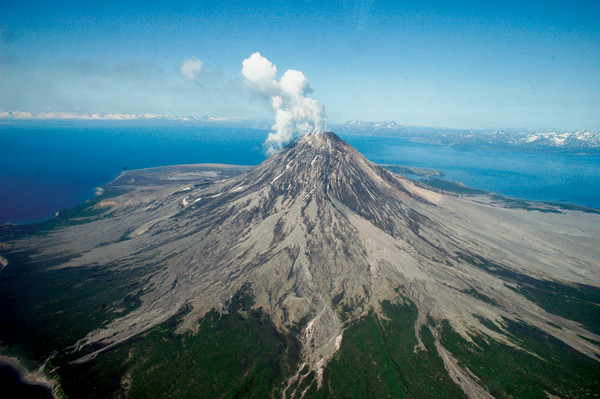
by Mary Caperton Morton Monday, July 28, 2014

Augustine is one of Alaska's most active volcanoes. Credit: Game McGimsey, AVO/USGS.
Located 280 kilometers southwest of Anchorage, Augustine is one of the most active volcanoes in the volcanically active state, erupting every 10 to 20 years. Because of its history of frequent eruptions — five blasts in the past 75 years — and close proximity to Anchorage and other communities in south-central Alaska, Augustine is one of the best-monitored volcanoes in the state. “You can see Augustine’s ash clouds from Anchorage, so people really pay attention to it,” says Helena Buurman, a volcano seismologist at the University of Alaska in Fairbanks and lead author of the new study, published in Geophysical Research Letters.
In mid-December 2005, Augustine reawakened after a 20-year hiatus, emitting a plume of sulfur dioxide steam and a fine coating of ash and triggering hundreds of small earthquakes in the weeks leading up to an explosive eruption on Jan. 13, 2006. On Jan. 12, seismic instruments detected a series of small, repeating earthquakes coming from the conduit just below the main summit vent.
“We detected more than 50 small earthquakes that looked almost exactly the same at first glance, but when we looked carefully at the waveforms, it became clear that the tremors were moving very slightly,” Buurman says. A detailed analysis of the seismic readings revealed that the source of the earthquakes was moving downward, deeper into the conduit.
“Moving upward would make sense since magma has to break a pathway up to the surface before it erupts, but downward is a little weird,” Buurman says. Using data gathered by GPS instruments, seismometers and thermal cameras, Buurman and colleagues pieced together the sequence of events underlying the tremors.
The earthquake sequence seemed to start with a small amount of lava coming out of the vent. “We think when the lava was exposed at the surface, it began to cool a bit and that was enough to hit a [temperature] sweet spot where magma repeatedly cracks and reforms, generating small earthquakes. As it continued to cool, that sweet spot moved down the conduit, creating the descending pattern of earthquakes,” Buurman says.
When magma cools, it becomes more viscous and less able to flow, thus clogging the conduit. “This plug at the top allowed the gas pressure to build up underneath and lent the eruption a bigger punch,” she says.
The sequence makes sense in light of Augustine’s well-known eruptive patterns, says Michelle Coombs, a volcanologist at the Alaska Volcano Observatory in Anchorage who was not involved with the new study. “These findings are consistent with what we know about this volcano from this eruption and past events.”
The pattern of repeating earthquakes will “undoubtedly be watched for when monitoring future eruptions,” Coombs says. “This volcano has a long history of very similar eruptions, so the odds are this kind of seismicity will happen again in the future.”
Other Alaskan volcanoes may follow a similar eruptive sequence, Buurman says, but more evidence will be needed to determine if repeating earthquakes caused by clogged conduits are a widespread occurrence. “This type of repeating earthquake has been seen elsewhere, such as at Alaska’s Mount Redoubt in 2009, but we’ve never quite been able to piece together the underlying cause. Augustine is so well monitored that we were finally able to put this story together.”
© 2008-2021. All rights reserved. Any copying, redistribution or retransmission of any of the contents of this service without the expressed written permission of the American Geosciences Institute is expressly prohibited. Click here for all copyright requests.